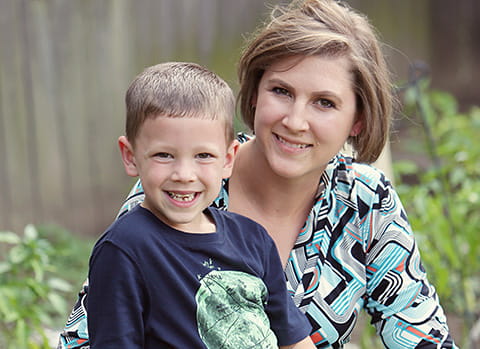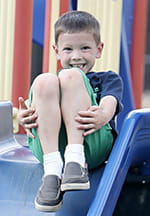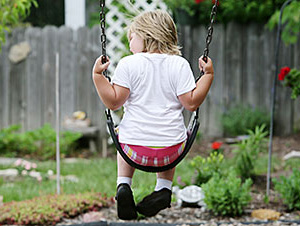
Logan was 4 years old when he met Sarah and Ben. He became a permanent part of their family last year.
Saving Children from Abuse and Neglect
It was a warm and sunny July afternoon. Logan was playing outside, full of nervous energy. Each car that passed made him anxious, as he waited for the one that carried his new foster parents.
Sarah and Ben drove slowly along the street, looking for the address the social worker gave them. Looking for the right house was a welcome distraction from their own nervous excitement about meeting Logan, their first foster child. When the right house number finally appeared, they took a deep breath and stepped out to see Logan playing, his bag waiting on the porch. After a brief introduction, Ben picked up Logan’s bag and Sarah held out her hand. Logan slipped his palm into hers and looked up, a hesitant smile across his face.
And in that moment, their lives changed forever.
Building Partnerships To Protect Kids
In the United States, approximately 900,000 children are victims of abuse or neglect each year, and more than five children per day die because of maltreatment. In Ohio alone, 34,000 children a year are victims, and because of underreporting, the actual number could be three times as high.
For the experts at Cincinnati Children’s, these statistics are a rallying cry – and the driving force behind two of our strongest efforts against child abuse – the Therapeutic Interagency Preschool program (TIP) and the Mayerson Center for Safe and Healthy Children.
Yet, addressing the problem of child abuse is complex and requires a closely connected partnership of many. That’s why both TIP and the Mayerson Center collaborate with an extensive group of partners, including county and city law enforcement, Hamilton County Jobs and Family Services and other social service agencies and community organizations to help kids escape and recover from abuse and neglect.
 Helping Traumatized Kids Succeed
Helping Traumatized Kids Succeed
At just 4 years old, Logan had already been through so much. He was removed from his biological mother when he was three, and Sarah and Ben were his fourth foster family in just 16 months. Moreover, because of the abuse and neglect he suffered in his young life, Logan had a long list of challenging behavioral problems.
“We actually didn’t know much about his background when we picked him up,” Sarah recalls. “We were to keep him overnight to get acquainted, and then I dropped him off at TIP the next day.”
Now in its 25th year, TIP is a comprehensive preschool program that integrates clinical and mental health services, as well as speech, occupational and physical therapy for 3- to 5-year-olds who have suffered abuse and neglect.
“We care for 60 children at a time and most suffer from post-traumatic stress disorder and severe behavioral problems,” says Jane Sites, EdD, LSW, the program’s executive director. “TIP offers them a safe preschool experience that helps them learn to cope with their trauma and thrive.”
The results are remarkable. “Children who participate in TIP for one year – even those who begin the program as the most at-risk – make the most developmental progress of any preschoolers in Hamilton County Head Start,” Sites says. “They hold their own with their peers when they start school.”
But that’s not all. What’s really extraordinary about TIP is that the preschool also offers traumatized kids an environment with peers who have similar experiences. “TIP gave Logan a sense of normalcy,” Sarah says. “At TIP, being in the foster care system is normal. Logan had friends his age who understood what he was going through. At an ordinary preschool, he wouldn’t have had that sense of belonging.”
Today, thanks to TIP, Logan is an active, sunny first grader, who loves Taekwondo and plans on being a school teacher when he grows up. He is still learning to cope with his past, but his future is bright, especially with Sarah and Ben in his corner.
“When we first decided to become foster parents, Ben and I both thought it would be a short-term thing. However, the best laid plans …” Sarah smiles wryly. “When Logan couldn’t go back to his birth mother, we knew we wanted him to stay permanently. We adopted him last year, and we couldn’t be happier to build our family with him.”
Working Toward A Brighter Future For Abused Kids
Like TIP, the Mayerson Center’s focus is on helping kids escape and recover from abuse and neglect. What’s more, as a division at Cincinnati Children’s, the Mayerson Center is able to have a wider focus in its work, which includes investigation of abuse cases, clinical and mental healthcare for abuse victims, research on the long-term effects of child abuse and trauma, and training for clinicians, social workers and investigators in child abuse care.
However, some of the Mayerson Center’s most groundbreaking work is found within its new Childhood Trauma Reduction Collaborative (CRTC). This unprecedented community initiative identifies, responds to and provides care for children suffering from what is known as “toxic stress”.
“Most cases of abuse happen when a child is young, when their brains are developing and lifelong pathways are being written. Abuse alters that development,” notes Robert Shapiro, MD, director of the Mayerson Center. “And not only does it adversely change how the brain develops, it can have a powerful negative impact on mental and physical health across their lifetime.”
In fact, due to its lifelong, detrimental effects, toxic stress has become a public health priority – and the Mayerson Center is leading the way to respond to this problem through the CRTC. Ultimately, the CRTC will act as a centralized community hub to screen kids for toxic stress and will improve the medical and community responses to trauma.
Making A Lifelong Difference
Finding and implementing better ways to respond to abuse across the community is a great start – but it’s not the end goal for the experts at the Mayerson Center.
“The best thing we can do for kids is to prevent abuse before it starts,” Dr. Shapiro says. “If we can help parents create a safe and nurturing home environment for their children, less abuse will happen and children will grow up healthier and better prepared to succeed.”
To that end, the Mayerson Center works with community partners that help parents and families learn better ways to communicate and interact. Because we know that will start a revolution – a more positive home environment means healthier kids. And healthier kids mean a healthier community.
“At the Mayerson Center, we care for about 2,000 kids a year. Imagine if we could reduce that number by half or, ideally, down to zero,” says Dr. Shapiro. His eyes light up. “That’s where my biggest hope lies – helping families create a safe home for kids. If we can do that across the community, we can make Cincinnati thrive.”
To learn more or support our work with abused and neglected children, contact Sarah Sullivan at 513-636-5664 or sarah.sullivan@cchmc.org.





